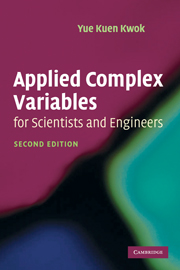Book contents
- Frontmatter
- Contents
- Preface
- 1 Complex Numbers
- 2 Analytic Functions
- 3 Exponential, Logarithmic and Trigonometric Functions
- 4 Complex Integration
- 5 Taylor and Laurent Series
- 6 Singularities and Calculus of Residues
- 7 Boundary Value Problems and Initial-Boundary Value Problems
- 8 Conformal Mappings and Applications
- Answers to Problems
- Index
6 - Singularities and Calculus of Residues
Published online by Cambridge University Press: 05 June 2012
- Frontmatter
- Contents
- Preface
- 1 Complex Numbers
- 2 Analytic Functions
- 3 Exponential, Logarithmic and Trigonometric Functions
- 4 Complex Integration
- 5 Taylor and Laurent Series
- 6 Singularities and Calculus of Residues
- 7 Boundary Value Problems and Initial-Boundary Value Problems
- 8 Conformal Mappings and Applications
- Answers to Problems
- Index
Summary
This chapter begins with a discussion of the classification of isolated singularities of complex functions. The classification can be done effectively by examining the Laurent series expansion of a complex function in a deleted neighborhood around an isolated singularity. An isolated singularity can be either a pole, a removable singularity or an essential singularity. The various forms of behavior of a complex function near an isolated singularity are examined. Next, we introduce the definition of the residue of a complex function at an isolated singularity. We show how to apply residue calculus to the evaluation of different types of integral. The Fourier transform and Fourier integrals are considered, and the effective use of residue calculus for the analytic evaluation of these integrals is illustrated. The concept of the Cauchy principal value of an improper integral is introduced. We also consider the application of residue calculus to solving fluid flow problems.
Classification of singular points
By definition, a singularity or a singular point of a function f(z) is a point at which f(z) is not analytic. A point at which f(z) is analytic is called a regular point of f(z). A point z0 is called an isolated singularity of f(z) if there exists a neighborhood of z0 inside which z0 is the only singular point of f(z).
- Type
- Chapter
- Information
- Applied Complex Variables for Scientists and Engineers , pp. 248 - 310Publisher: Cambridge University PressPrint publication year: 2010



